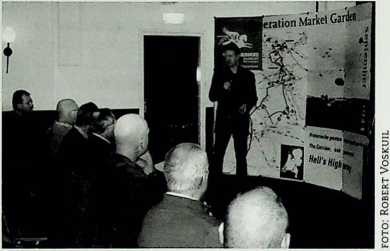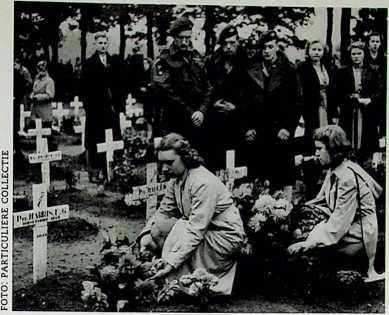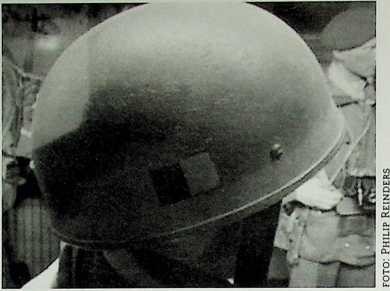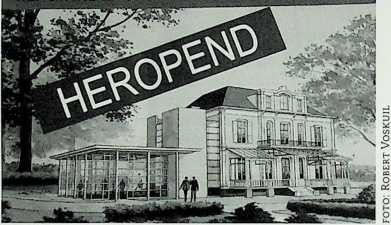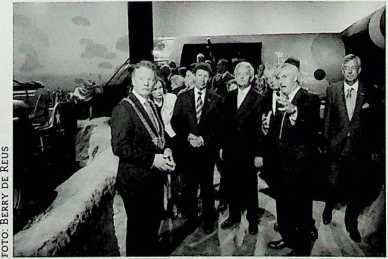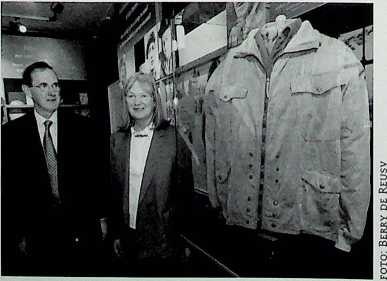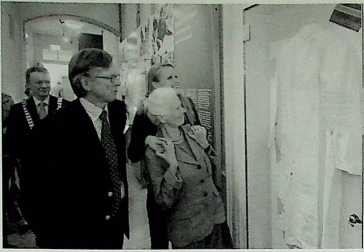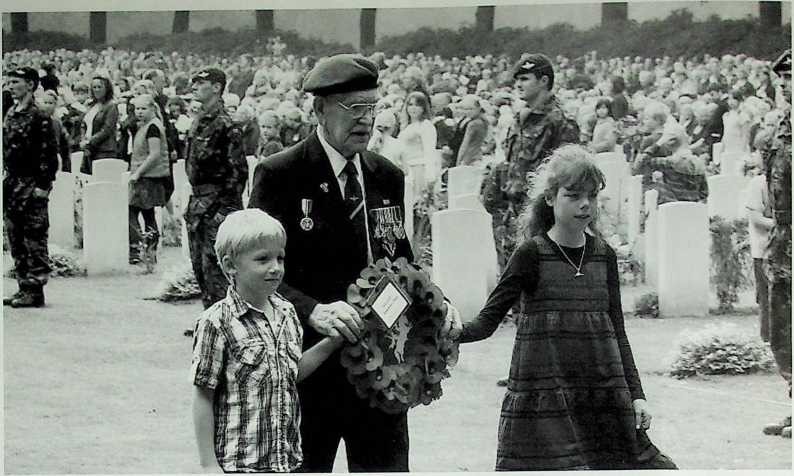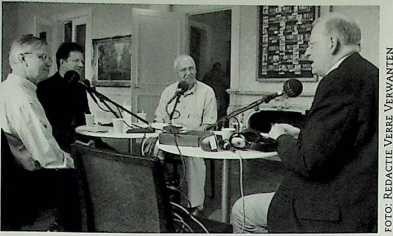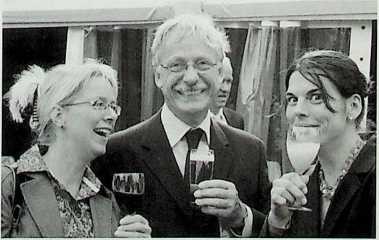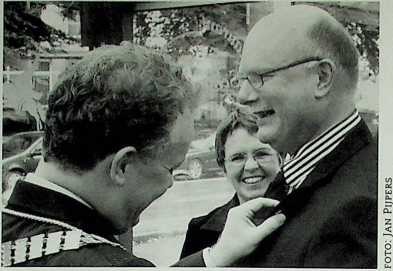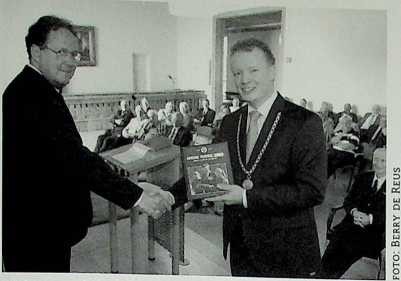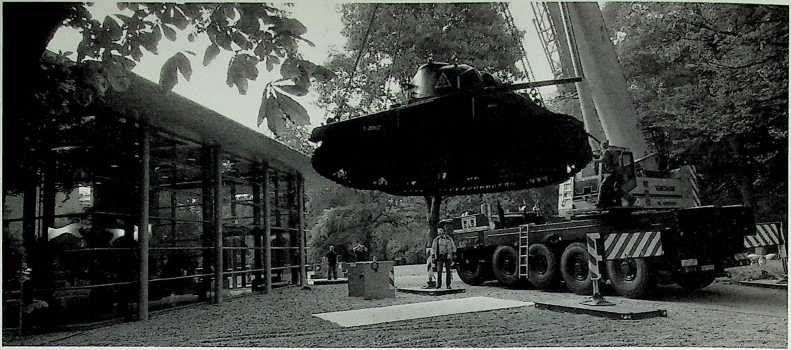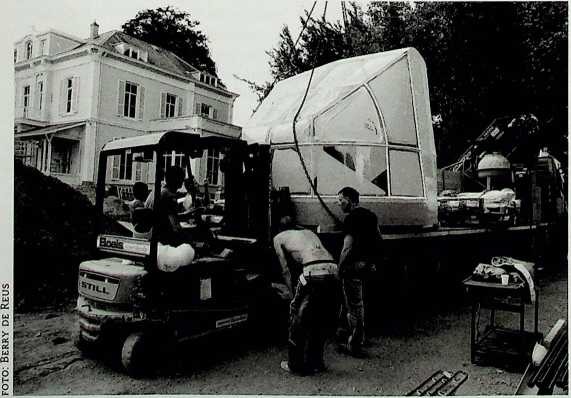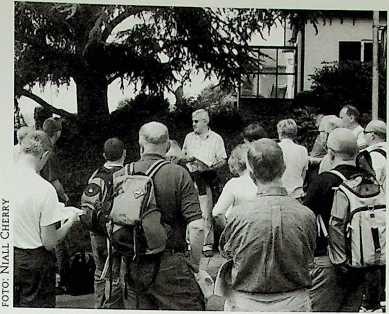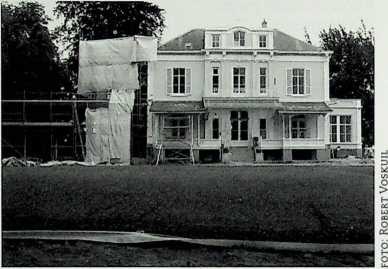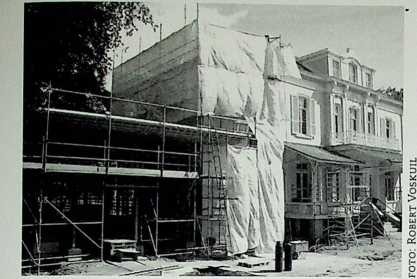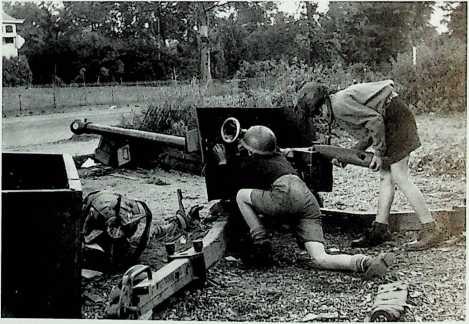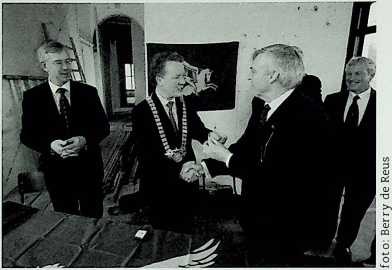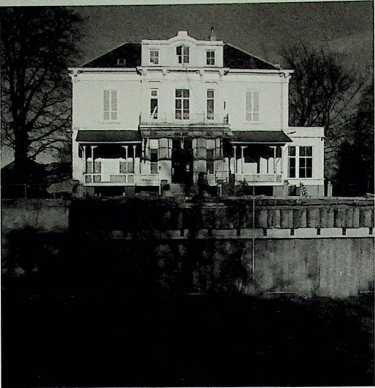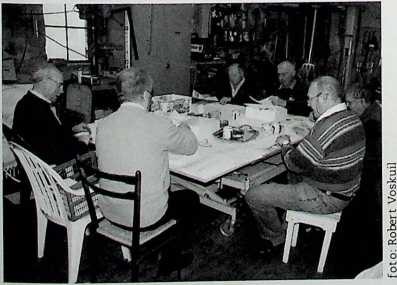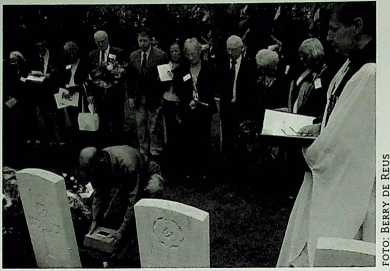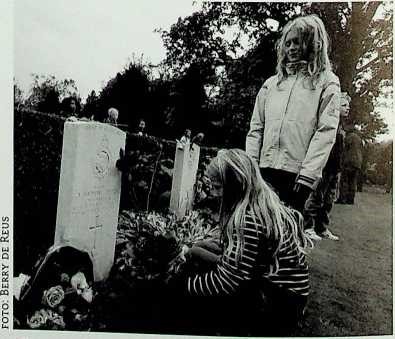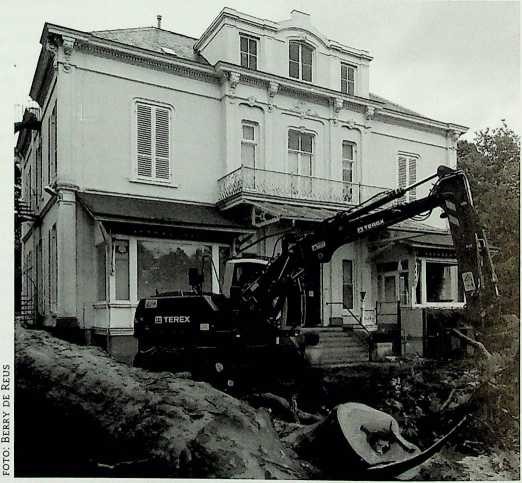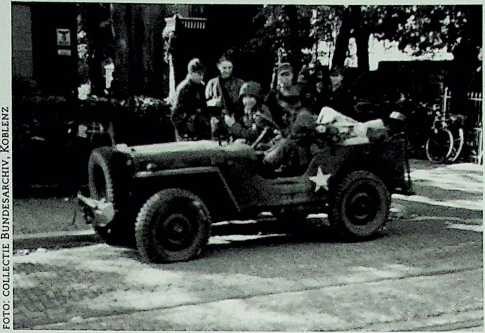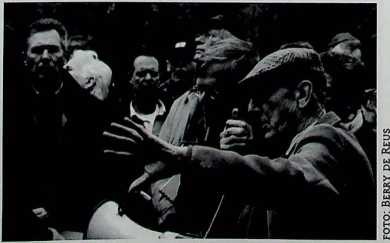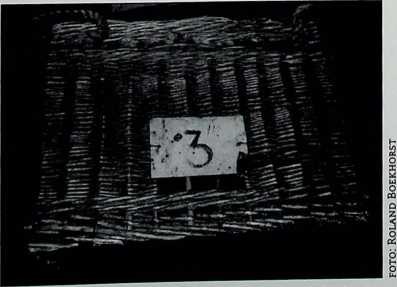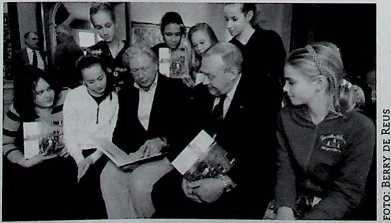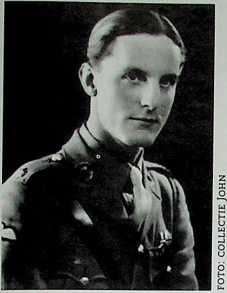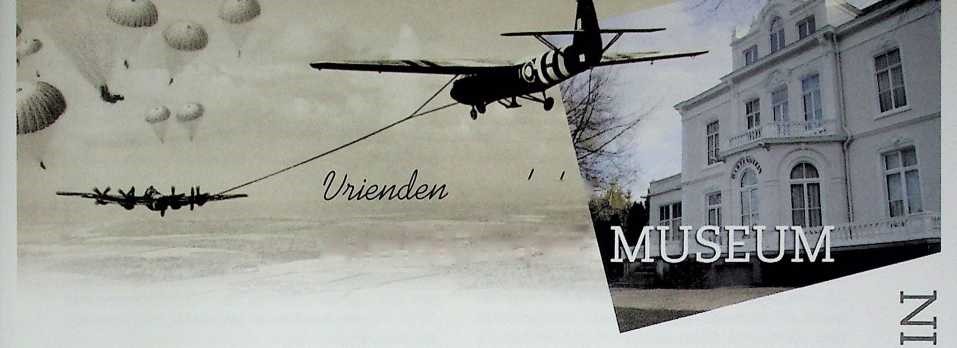
24 April 2010. Aad Groeneweg (midden) en Wybo Boersma (rechts) bedanken Driekus Heij voor de ‘Gouden Speld’, die zij zojuist hebben ontvangen.
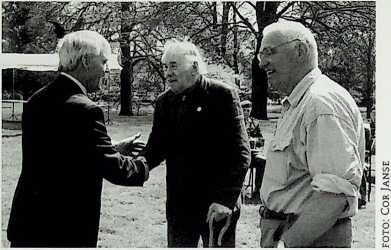
Gouden spelden op de Boekenbeurs
Op zaterdag 24 april werd weer de jaarlijkse boekenbeurs gehouden bij het Airborne Museum in Oosterbeek. Het bestuur van de Stichting Airborne Museum vond dat een goede gelegenheid om twee voormalige bestuursleden van de stichting, Wybo Boersma en Aad Groeneweg, te belonen voor het vele werk dat zij gedurende tientallen jaren voor het museum hebben verricht. Driekus Hey, voorzitter van de stichting, overhandigde hen, na een lovende speech, de ‘Gouden Speld’ van het Airborne Museum. Mede namens Aad bedankte Wybo voor het gebaar van het stichtingsbestuur. Het geheel werd afgesloten met marsmuziek, uitgevoerd door de Historische Band van de Verbindingsdienst.
Dagboeken geschonken
Op zaterdagmiddag 27 maart vond er in het Airborne Museum een bijeenkomst plaats, waarbij twee originele dagboeken uit september 1944 en een aantal bijzondere voorwerpen werden overgedragen aan het Airborne Museum. De dagboeken werden geschreven door dokter Carl Giesberts en door Anje van Maanen. Beiden woonden tijdens de oorlog in Oosterbeek. Anje, dochter van de Oosterbeekse huisarts Van Maanen, was 17 jaar in 1944. De zoon van dokter Giesberts, die later ook huisarts werd in Oosterbeek, vond de dagboeken tussen allerlei papieren van zijn overleden vader. Hij besloot de tekst zorgvuldig over te typen en het originele handgeschreven exemplaar over te dragen aan het Airborne Museum. De heer Giesberts heeft inmiddels het dagboek van zijn vader als boekje uitgegeven. Wij komen daar in het volgende nummer van de Nieuwsbrief op terug. Anje van Maanen, die inmiddels in de tachtig is, was bij de overdracht van de beide dagboeken aanwezig. Uit de nalatenschap van haar vader werden ook een Rode Kruishelm en een Rode Kruisvlag geschonken aan het Airborne Museum. Dit gebeurde door de achter-achter kleinzoon van dokter van Maanen.
Logo ‘Guild of Battlefield Guides’
De Vereniging Vrienden van het Airborne Museum gaat bij haar battlefield tours gebruik maken van het logo van de ‘Guild of Battlefield Guides’ (GBG). Dit houdt in dat bij alle publicaties over battlefield tours en op de website van de Vrienden het logo van de Guild staat. Deze is dan gelinkt aan de website van de Guild www.gbg-intemational.com . De website van de GBG wordt gelinkt aan de website van de Vrienden. Minstens 50% van de van de gidsen dienen lid te zijn van de Guild en de VVAM garandeert dat de tours uitgevoerd worden volgens de standaard van deze organisatie. De GBG is een organisatie met circa 300 leden, afkomstig uit ongeveer tien landen. De leden zijn full-time of part-time gidsen, battlefield tour operators en belangstellenden in slagvelden. De Guild houdt regelmatig bijeenkomsten voor leden, waarbij ondermeer bezoeken aan slagvelden worden gebracht, lezingen worden gehouden en ervaringen worden uitgewisseld op het gebied van battlefield tours. Ook is er de mogelijkheid om examens af te leggen voor het behalen van de Guild badge. In het verleden zijn er in het Verenigd Koninkrijk bijeenkomsten geweest in Uxbridge, Southwick House bij Portsmouth, Londen, Shrivenham Defence College en in Woolwich. Buiten Engeland zijn er bijeenkomsten geweest in Arnhem, Waterloo en Calais. In oktober en november van dit jaar is er een battlefield tour in Zuid-Afrika met als onderwerp de Zoeloe- en de Boerenoorlog. Door deze overeenkomst met de GBG krijgt de Vereniging Vrienden meer naamsbekendheid bij een groot aantal battlefield gidsen en bij voornamelijk de Britse touroperators. Veel van deze gidsen en touroperators bezoeken jaarlijks het gebied van ‘Market Garden’ en in het bijzonder Arnhem. Dat de VVAM dit logo mag gaan gebruiken is een erkenning van het hoge peil van onze battlefïeld tours. (Wybo Boersma)
Restanten voormalig groepsgraf gevonden
Op 21 januari 2009 werden aan de Sonnenberglaan in Oosterbeek, bij graafwerkzaamheden ten behoeve van de riolering, enkele skeletresten, Britse militaire uit-rustingsstukken en munitie aangetroffen. De arbeid werd onmiddellijk gestaakt, en de Bergings- en Iden- tifcatie Dienst (BIDKL) en het Explosieven Opruimings Commando van de Koninklijke Landmacht (EOCKL) ter plaatse geroepen. Het bleek te gaan om restanten van een voormalig groepsgraf van circa zeven Britse soldaten, dat gedurende of direct na de gevechten in september 1944 moet zijn aangelegd. Alle uitrusting en munitie zijn in 1945-1946 achtergelaten, toen de lichamen werden opgegraven en overgebracht naar het Airborne Kerkhof. Mogelijk vanwege de verterings- verschijnselen zijn toen enkele stoffelijke resten in het graf achtergebleven. Ondanks nauwgezet onderzoek van de vondsten door de BIDKL is het niet mogelijk gebleken om te achterhalen tot wie de aangetroffen resten behoren. Daarom zullen deze, in overleg met het Britse Ministerie van Defensie en de Commonwealth War Graves Commission, worden bijgezet in een verzamelgraf op de militaire begraafplaats in Oos-terbeek. Onder de uitrustingsstukken bevonden zich onder andere zeven helmen ‘Airborne troops’ (voor de liefhebbers: Ist Pattern ‘fiber rim’ en MK I ‘steel rim), een body armour suft (scherfwerend vest), diverse ankle boots (driekwart hoge gevechtslaarzen), delen van een escape kit (ontsnappingspakket), fragmenten van een gele recognition scarf (herkenningssjaal), enkele sjaals gesneden uit parachutestof, en diverse webbing equipment (uitrustingsstukken). Persoonlijke bezittingen en wapens werden niet gevonden. De aangetroffen muni-tie bestond uit een dozijn Mills No. 36 handgranaten, een grote hoeveelheid .303 patronen en enkele Bren- magazijnen. Deze zijn door het EOCKL veilig gesteld. (Geert Jonker)
‘With Nothing Bigger than A Bren Gun’ (2)
De meeste leden weten vast nog wel dat mijn boekje ‘With Nothing Bigger than A Bren Gun’ in januari 2008 uitkVVAM, en velen zullen een exemplaar aangeschaft hebben. Het gaat over de verdediging van de Van Limburg Stirumschool bij de verkeersbrug in Arnhem door Britse parachutisten in september 1944. Zoals gewoonlijk heb ik niets te verbergen, en ook in dit geval had ik mijn adres vermeld. Mensen die dat op prijs stellen, kunnen op die manier in contact komen met mij. Een van de veteranen die er destijds bij was in de school, was bevriend gebleven met de familie van een genist die uiteindelijk was overleden aan de verwondingen die hij tijdens de Slag om Arnhem had opgelopen. Zonder dat ik dat wist, had hij nadat ik hem een exemplaar van mijn boekje had verkocht, die familie erover ingelicht, en mijn adres doorgegeven. En zo kVVAM het dat op een zaterdagmiddag een man aan mijn voordeur klopte. Hij zocht mij omdat hij een
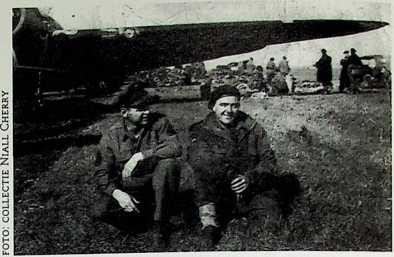
Sapper Norman Butterworth en Sergeant Philip Waugh op het vliegveld Barkston Heath, 17 september 1944. De mannen staan naast Waughs vliegtuig (roepnaam U-Uncle), een C-47 (Dakota) van 15th Troop Carrier Squadron, 61st Troop Carrier Group, United States Army Air Force. Barkston Heath was de hoofdbasis vanwaar Ist Parachute Brigade naar Arnhem vloog. Op deze dag stegen in totaal 72 vliegtuigen op, waarvan 18 stuks van 15th TCS waren. Norman vloog in het toestel met roepnaam G-George van Technical Sergeant Weaver (flight engineer), die met Waughs camera deze foto nam.
familielid was van Norman Butterworth, en omdat hij wilde weten of ik geïnteresseerd was om wat papieren te bekijken die zij sinds 1944-1945 bewaard hadden. Natuurlijk was mijn antwoord ‘Ja!’, en een paar weken later arriveerde een envelop met diverse documenten. Ik wil de andere Vrienden daar nu graag kennis mee laten maken. Echter, voordat ik dat doe, moet ik eerst wat vertellen over Norman. Hij behoorde tot het Ist Parachute Squadron, Royal Engineers, en daar was hij al bij sinds de oprichting. In Arnhem liep hij verwondingen aan de benen op toen hij door de Duitsers werd beschoten terwijl hij zich, met een wit stuk doek aan z’n geweer, wilde overgeven op 20 september 1944. In de Roll of Honour staat zijn sterfdatum als 27 februari 1945 vermeld, en toen lag hij in een Apeldoorns ziekenhuis. Zijn laatste rustplaats kreeg hij op de Arnhem Oosterbeek War Cemetery in graf 18 C 9. Welnu, terug naar de envelop. Daarin zat onder andere een foto die werd genomen op het vliegveld Barkston Heath op de ochtend van zondag 17 september 1944. De afbeelding is bij dit artikel afgedrukt, en we zien Norman en een lid van een Amerikaanse vliegtuigbemanning. Waarschijnlijk is dit de eerste keer dat de foto op deze schaal wordt geopenbaard. Er zat ook een brief bij van deze Amerikaan. Er waren nog vier andere brieven die wat mij betreft zeer belangrijk zijn. Twee werden in november 1944 door Norman geschreven in Apeldoorn, en waren gericht aan zijn familie. Het derde document is een exemplaar van de tekst van een brief van de Nederlandse verpleegster Betty Meyer aan Norman, gedateerd 28 september 1944. En tenslotte is er een schrijven van een Major Rigby-Jones uit september 1945. Major G. Rigby-Jones was als chirurg verbonden aan 181 Airlanding Field Ambulance, Royal Army Medical Corps, en in september 1944 werkte hij op diverse locaties in Wolfheze en Oosterbeek. Aan het eind van de gevechten kwam hij in Apeldoorn terecht. Zijn brief is gericht aan Normans echtgenote,
en bevat onder andere de mededeling dat de genist op 26 oktober 1944 onder de hoede van de medicus kVVAM. Het ging heel goed met hem, totdat hij begin februari 1945 erysipelas opliep als gevolg van een desbetreffende epidemie in het Duitse hospitaal. Major Rigby-Jones voegde eraan toe dat Norman vervolgens een bloedvergiftiging kreeg, en dat hij op de 21e van die maand stierf. Uit een medisch woordenboek blijkt wat erysipelas is: wondroos, een acute infectieziekte van de huid en het subacute bindweefsel, gekenmerkt door koorts, roodheid, zwelling en algemeen ziektegevoelen, veroorzaakt door Streptococcus pyogenes Rosenbach. Op zondag 20 september 2009 heb ik namens Normans familie de documenten in eigendom overgedragen aan Dick Schlüter, toenmalig directeur van het Airborne Museum ‘Hartenstein’, ter bewaring in het museumarchief. Helaas heb ik geen exemplaren over van het boekje ‘With Noting Bigger than A Bren Gun’, en ik heb geen plannen voor een herdruk. Belangstellenden kunnen hun geluk beproeven op het internet of bij een antiquariaat. (Niall Cherry)
‘Retake Arnhem Bridge’
Op 20 februari jl. werd in restaurant Schoonoord in Oosterbeek het boek ‘Retake Arnhem Bridge’ van Bob Gerritsen en Scott Reveil gepresenteerd. Dit boek, met als ondertitel: ‘An illustrated history of Kampfgruppe Knaust September-October 1944’ is opgebouwd rond foto’s, die door een lid van de Kampfgruppe Knaust, Karl-Heinz Kracht, tijdens zijn diensttijd zijn genomen. In het verleden had Kracht een aantal van deze foto’s, genomen tijdens de Slag om Arnhem, aan het Airborne Museum geschonken. Deze zijn daarna in verschillende publicaties verschenen. Uit onderzoek van Bob Gerittsen bleek dat er veel meer foto’s waren die zijn gehele diensttijd bestreken. Het boek is uit een aantal delen opgebouwd. In de eerste twee hoofdstukken wordt een rijk geïllustreerd beeld gegeven van Kracht’s tijd bij de Reichs Arbeits Dienst en zijn training in Bielefeldbij de Panzer-Ersatz- und Ausbüdungs- Abteilung 11. Hoofdstuk 3 in het boek, dat handelt over ‘Arnhem’, zal voor de meeste lezers het interessantste deel zijn. Hierin worden de gevechten rond de Rijnbrug in Arnhem beschreven, gezien in het licht van het optreden van de Kampfgruppe Knaust, waar de Panzer-Ersatz- und Ausbildungs-Abteilung 11 dan deel van uitmaakt. De vaak onbekende en gecompliceerde samenhang tussen de verschillende Duitse eenheden, die ingezet worden bij de herovering van de Rijnbrug, wordt door de schrijvers duidelijk aangegeven. Citaten uit dagboeken en andere verslagen van voornamelijk Duitsers geven een persoonlijke noot. Jammer dat hier en daar voetnoten of bronvermelding ontbreken. Zo wordt aangegeven dat het FLAK geschut op de brug door een PIAT in combinatie van een vlammenwerper werd uitgeschakeld. Dit wordt als zodanig voor het eerst vermeld door kapitein Eric MacKay R.E. Andere verslagen geven echter aan dat het door een 6-ponder anti-tankkanon in combinatie met een vlammenwerper uitgeschakeld zou zijn, wat gezien de positie van de FLAK met de bebouwing daarbij, waarschijnlijker is. In verschillende publicaties wordt de vraag gesteld waarom Grabner met zijn verkenningseenheid over de Rijnbrug teruggetrokken is. Volgens de schrijvers van ‘Retake Arnhem Bridge’ kreeg hij hiervoor bevel van de Chef-Staf van de Hohenstaufen divisie maar uit welke bron dit gegeven afkomstig is wordt helaas niet aangegeven. De foto’s die Kracht maakte bij de Rijnbrug worden goed aangevuld met foto’s van verschillende Duitse verslaggevers en foto’s genomen na de gevechten. Het vierde hoofdstuk telt 60 pagina’s en geeft een beeld van de gevechten in de Betuwe waar de Kampfgruppe Knaust dan ingezet wordt. Hier heeft Kracht slechts enkele foto’s genomen, zodat de schrijvers hun toevlucht hebben moeten zoeken bij andere Duitse en Britse bronnen. De beschrijving van de gevechten in de Betuwe bij ondermeer Eist, Driel en Bemmel geeft meer informatie over de inzet van de verschillende Britse bataljons. Een aantal minder bekende foto’s van Duitse troepen bij de Rijnbrug na de Slag om Arnhem identificeren deze als eenheden als zijnde van de 116e Panzerdivisie. Er is geen bronvermelding bij. Andere bronnen uit Amerika geven aan dat ze door PK Berichter Gorokhoff of Stachelscheid genomen zouden zijn, maar het is niet zeker of dat juist is. Een foutje in de benaming van de ‘Ist Polish Independent Parachute Brigade’ als ‘Polish Ist Independent Parachute Brigade’ (pagina 89) mag de schrijvers worden vergeven. Bijdragen van Marcel Zwarts over de verschillende pantservoertuigen en van Hans Timmerman over de Duitse verliezen van de Kampfgruppe Knaust tijdens de Slag om Arnhem, evenals een facsimile van de Duitse stafkaart ‘West Arnhem’ uit 1940, die bij het boek is gevoegd, zijn een welkome aanvulling. Kortom, het boek gaat over meer dan alleen de herovering van de Rijnbrug. Zoals we gewend zijn van de uitgever is ook dit boek uitstekend verzorgd met goed afgedrukte foto’s en kaarten. De Engelse taal is eenvoudig gehouden, zodat die geen groot bezwaar kan zijn voor de meeste Nederlanders. Het is een boek dat zijn prijs meer dan waard is en niet mag ontbreken in de boekenkast van een ieder die geïnteresseerd is in de Slag om Arnhem. ‘Retake Arnhems Bridge, An Illustrated History of Kampfgruppe Knaust September-October 1944′ door Bob Gerritsen and Scott Reveil telt 168 pagina’s en is geïllustreerd met foto’s en kaarten. Uitgegeven bij R.N. Sigmond Publishing, Renkum 2010, ISBN 978-90- 812703-3-5, De prijs bedraagt € 39,50. (Wybo Boersma)
Nieuw monument voor het Wiltshire Regiment
In de nasleep van de Slag om Arnhem vonden in de Betuwe, in het gebied waar nu de nieuwe Arnhemse wijk ‘De Schuytgraaf’ verrijst, hevige gevechten plaats tussen twee bataljons van het Britse Wiltshire Regiment en Duitse troepen. Op 20 september 1944 waren het 4e en het 5e bataljon van het Wiltshire Regiment (129e Brigade, 43e Wessex Divisie) over de Nederlandse grens getrokken, waarna zij werden ingezet in de Betuwe. Daar waren de bataljons vervolgens betrokken bij felle gevechten in het toen nog landelijke gebied van ‘de Schuytgraaf, o.a. bij de spoorwegovergang van de ‘Gouden Klomp’ naar ‘De Laar’. Ook bij de toenmalige boerderij ‘De Laar’ werd hevig
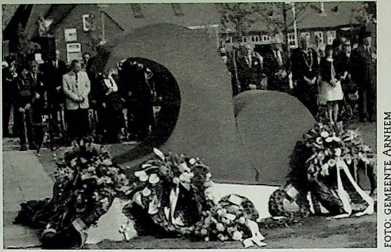
28 april 2010. Het nieuwe monument voor de Wiltshires in de wijk ‘de Schuytgraaf’ in Arnhem-Zuid
gevochten. Ondanks de onophoudelijke zware Duitse aanvallen, wisten de bataljons echter hun stellingen te behouden en daarmee de geallieerde corridor naar Driel open te houden. Op 5 oktober 1944 werden ze afgelost door eenheden van de Amerikaanse 101e Airborne Divisie. Tussen 23 september en 5 oktober verloren de twee bataljons samen 73 gesneuvelden! In december 1944 bliezen Duitse troepen bij Elden de Rijndijk op en kVVAM het land van ‘de Schuytgraaf, grotendeels onder water te staan. Hierdoor werd het na de bevrijding erg moeilijk om alle gesneuvelden op te sporen. Tijdens de bouwwerkzaamheden van nieuwbouwwijk ‘de Schuytgraaf werden in 2001 en 2003 nog twee soldaten van het Wiltshire Regiment geborgen. Vandaag de dag zijn er echter nog altijd 18 soldaten van dit regiment vermist. Om de offers die de Wiltshires brachten niet te vergeten, is er nu een herdenkingsmonument opgericht. Het werd op 28 april jl. onthuld door de Arnhemse burgemeester Pauline Krikke, samen met de veteraan Mr. Ray Hare, die in 1944 aan de gevechten deelnam. Het monument staat ten westen van ‘De Buitenplaats’ (Marasingel 19), de voormalige boerderij ‘De Laar’. De onthulling werd bijgewoond door verschillende diplomatieke en militaire hoogwaardigheidsbekleders. Het Wiltshire Monument heeft de vorm van een reeks golven en is uitgevoerd in staal. De golven staan symbool voor de lange weg die de mannen van het 4e en 5e bataljon van het Wiltshire Regiment na hun landing in Normandië op 18 juni 1944 hadden afgelegd en de voortdurende Duitse aanvalsgolven uit oostelijke richting, die de twee bataljons bij de gevechten in de Betuwe trachtten te overspoelen.
Oproep van de ‘Werkgroep Vermiste Personen Tweedewereldoorlog’
In de namiddag van 17 september 1944 – tijdens de Slag om Arnhem – kwam de 19-jarige Jan van der Linden thuis (Pontanuslaan te Arnhem) en vertelde zijn ouders dat er gevechten gaande waren tussen Geallieerde luchtlandingstroepen en Duitsers in de omgeving van het St. Elisabeths Gasthuis aan de Utrechtseweg. Vervolgens ging hij naar dat ziekenhuis om dienst te doen als gewondendrager. De volgende dagen lag het ziekenhuis in de vuurlinie en was afwisselend in Britse of Duitse handen. Tenslotte kwam het permanent in Duitse handen. Volgens geruchten, zouden de Duitsers toen het bevel gegeven hebben dat alleen Duitse gewonden mochten worden binnengedragen. Jan van der Linden moet hier tegen geprotesteerd hebben – ‘Ik draag niet alleen Moffen, maar alle gewonden’ – en werd gevan-gengenomen, waarschijnlijk door mannen van de 9e SS Pantserdivisie. Na 17 september 1944 hebben zijn ouders hem niet meer gezien of iets van hem vernomen. Volgens zijn vader zou hij, net als zoveel andere gewondendragers, een Engels uniform hebben aangetrokken en mogelijk als onbekende soldaat zijn begraven of tegelijk met een groep Engelse krijgs-gevangenen weggevoerd zijn richting Apeldoorn op 20 of 21 september 1944. Volgens een andere bron zou hij vermist zijn geraakt op 18 of 19 september 1944 in de omgeving van de Apeldoornseweg en park Sonsbeek (hoek Apeldoornseweg/Kluizeweg). Volgens het verhaal van een, inmiddels overleden, getuige, die in die tijd ook aan de Potanuslaan woonde, zou Jan hebben geholpen om te voet een gewonde op een brancard van het St. Elisabeths Gasthuis over te brengen naar het Gemeente Ziekenhuis aan de Wagnerlaan. Hij zou tijdens deze tocht zijn doodgeschoten door een Duitse soldaat. Kort daarna werden alle bewoners van de Pontanuslaan geëvacueerd en kon de familie niet verder navragen wat met Jan gebeurd kon zijn. Een andere voormalige gewondendrager kon zich eind 2009 niets van Jan van der Linden herinneren en volgens hem was de opdracht om alleen Duitse gewonden te vervoeren niet gegeven. Graag zou ik meer willen weten over Jan van der Linden en de manier waarop hij om het leven is gekomen. Reacties kunt u sturen naar Piet Dam (Werkgroep Vermiste PersonenTweedewereldoorlog), email: damheinst@kabelfoon.nl.
COLOFON
De Nieuwsbrief is een uitgave van de Vereniging Vrienden van het Airborne Museum, Oosterbeek en verschijnt vier keer per jaar. Het doel is bekendheid te geven aan het Airborne Museum, de activiteiten van de Vereniging Vrienden en de geschiedenis van de Slag om Arnhem. Redactie: drs. Robert P.G.A. Voskuil, Wybo Boersma en Joop Bal.
Coördinatie verzending, archivering & distributie losse num-mers Nieuwsbrief: Chris van Roekel, Oosterbeek.
Vormgeving Nieuwsbrief: Hildebrand DTP, Wageningen.
Druk: Drukkerij Verweij Wageningen B.V.
E-mail adres VVAM: info@vriendenairbornemuseum.nl.
Telefoon: (0318) 63 96 33.
Postadres: VVAM, t.a.v. Ivar Goedings, Postbus 8047, 6710 AA, Ede.
Penningmeester en Coördinator Airborne Netvs Flash: Vincent Luyten.
Website van de VVAM: www.vriendenAirbornemuseum.nl

